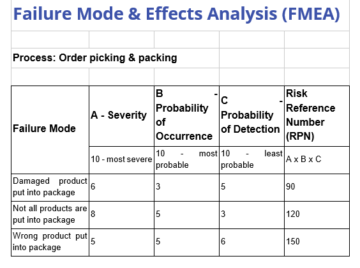Slack fill refers to the space remaining when manufacturers opt not to put as much product in a package as could fit. However, there is both functional slack fill and non-functional slack fill. Here’s a closer look at the differences.
What Do United States Regulators Consider Functional Slack Fill?
The U.S. Food and Drug Administration (FDA) provides six definitions of functional slack fill. The FDA also considers the packaging misleading if manufacturers fail to sufficiently fill the packaging for reasons other than these.
They are:
- Extra space used to protect the contents
- Extra space provided due to the machine-related requirements associated with packaging the items
- Extra space that occurs when the product naturally settles during shipment
- Extra space related to packaging that supports the preparation or consumption of a food
- Extra space associated with reusable containers that aid in presenting the food and have a significant value after people consume the food. Promotional and commemorative durable containers not meeting the first criteria also fall into this category, as do gift sets.
- Extra space caused by an inability to increase the fill volume or reduce the packaging size due to food labels or tamper-resistant aspects and efforts to facilitate handling or discourage pilfering
Non-functional slack fill is anything not aligned with the situations above. People see these examples more often than they might realize. Consider, for example, the potato chips cushioned in bags containing significant amounts of air or the holiday gift sets that come in metal boxes much too large for the number and size of the products.
The FDA also stipulates it considers packages misleading if they have non-functional slack fill and do not have designs that let consumers see inside. That detail confirms that the packaging can go beyond functional slack fill, but it’s up to buyers to decide whether to get the product.
The European Union Treats Slack Fill as a Broader Part of Packaging Waste
The European Commission does not list specific types of functional slack fill. In November 2022, it proposed new packaging rules that would affect all of the European Union if enacted. Coverage of the proposal mentioned the average of 180 kilograms of packaging waste generated per year by every European.
The initiative is multifaceted and advocates for the following:
- Eliminating unnecessary packaging
- Prioritizing reusable packaging
- Limiting overpackaging
- Providing clear recycling-related labels
- Working toward climate neutrality by 2050
- Decreasing the use of virgin materials
- Giving guidance about environmentally friendly materials
However, the legislation’s three main objectives are to:
- Prevent packaging waste by restricting unnecessary packaging and prioritizing reusable and refillable options
- Create an economically viable way to make all packaging used in the European Union recyclable by 2030
- Reduce the dependence on primary natural resources, including by encouraging the use of recycled plastics for packaging and setting associated mandatory targets
These aspects show that people determining whether their packaging has functional slack fill or some that’s useless must take a broader perspective than what the U.S. requires. However, it’s too early to know whether the Commission’s proposal will become law, and what that looks like in practice.
A notable difference in how the U.S. and the EU approach functional slack fill, is that the EU has a sustainable viewpoint that takes the environmental effects of waste into consideration. On the other hand, the U.S. laws are more favorable to slack fill and corporations can justify its implementation.
What Are the Consequences of Failing to Prevent Non-Functional Slack Fill?
Manufacturers must proactively avoid non-functional slack fill. Some beverage companies have machines that automatically detect the container type and size, comparing it to data about how much to fill it. Spending more time in the design phase to develop solutions that adequately protect products without requiring excessive packaging is another approach.
Companies otherwise face various undesirable outcomes. However, the tricky part is that no laws codify the acceptable amount to fill a product’s container. That’s probably why it’s usually hard for class-action lawsuit members to win. Even so, most company leaders would agree that money towards a lawsuit is better spent elsewhere.
Another thing to keep in mind is that people don’t usually think about functional slack fill and non-functional slack fill or even know the difference between the two. They typically just see excessive packaging and take issue with it.
One study of European e-commerce shoppers found 53% of respondents viewed sustainability as an important driver as they choose where to buy things. However, many people have used social media to bring attention to companies that used far too much packaging and misled consumers with package sizes that were far too big for the contents. When people see so much packaging waste, it’s hard for them to also perceive companies as caring about the environment.
The Washington Post also recently covered the slack fill associated with boxes of Valentine’s Day chocolates. The packages were less than half full of candies with the packaging inserts removed. If people like companies have swindled them with slack-fill scams, many will start doing business with other brands.
Although the FDA’s six definitions of functional slack fill repeatedly mentioned food, the problem of products sold in less-than-full containers spans to other categories. One recent proposed class-action suit alleges containers of L’Occitane lotion have nearly 50% non-functional slack fill. The document’s contents also take issue with how the packaging lacks a fill line, which would allow people to see how much lotion was inside.
Communication and Transparency Prevent Slack-Fill Surprises
People who oversee packaging design must proactively work to reduce instances of customers assuming packages have non-functional slack fill. However, they can be upfront about functional slack fill by making it easy to see inside the packaging and creating exterior fill lines when applicable. Messaging that lets customers know that manufacturers sell products by weight and not volume or that contents settle during shipping can also set the right expectations.
Author Bio:
Emily Newton is the Editor-in-Chief of Revolutionized Magazine. She has over five years covering stories about warehousing, logistics and distribution.
- SEO Powered Content & PR Distribution. Get Amplified Today.
- Platoblockchain. Web3 Metaverse Intelligence. Knowledge Amplified. Access Here.
- Source: https://www.allthingssupplychain.com/when-is-slack-fill-functional-and-when-is-it-wasted-space/?utm_source=rss&utm_medium=rss&utm_campaign=when-is-slack-fill-functional-and-when-is-it-wasted-space
- :is
- $UP
- 100
- 2022
- a
- About
- above
- acceptable
- adequately
- administration
- advocates
- affect
- After
- Aid
- AIR
- aligned
- All
- alleges
- amounts
- and
- Another
- applicable
- approach
- ARE
- AS
- aspects
- associated
- At
- attention
- automatically
- average
- avoid
- bags
- BE
- become
- Better
- between
- BEVERAGE
- Beyond
- Big
- boxes
- brands
- bring
- broader
- business
- buy
- buyers
- by
- CAN
- categories
- Category
- caused
- CFM
- Chips
- Choose
- clear
- Climate
- closer
- come
- commemorative
- commission
- Companies
- company
- comparing
- Consequences
- Consider
- consideration
- considers
- consume
- Consumers
- consumption
- Container
- Containers
- contents
- Corporations
- could
- coverage
- covering
- Creating
- criteria
- cushioned
- Customers
- data
- day
- decide
- dependence
- Design
- designs
- detail
- determining
- develop
- difference
- differences
- distribution
- doing
- Dont
- driver
- drug
- during
- e-commerce
- Early
- easy
- editor-in-chief
- effects
- efforts
- elsewhere
- encouraging
- Environment
- environmental
- environmentally
- environmentally friendly
- EU
- Europa
- European
- european commission
- european union
- Even
- Every
- example
- examples
- expectations
- Face
- facilitate
- FAIL
- Fall
- far
- fda
- fill
- First
- fit
- following
- food
- Food and Drug Administration
- Food and Drug Administration (FDA)
- For
- found
- friendly
- full
- functional
- get
- gift
- Go
- guidance
- Half
- hand
- Handling
- Hard
- Have
- Holiday
- How
- However
- HTTPS
- implementation
- important
- in
- inability
- Including
- Increase
- Initiative
- Inserts
- issue
- IT
- ITS
- jpg
- Keep
- Know
- Labels
- large
- Law
- Laws
- lawsuit
- leaders
- Lets
- like
- Line
- lines
- List
- logistics
- Look
- LOOKS
- Machines
- magazine
- Main
- make
- Making
- mandatory
- Manufacturers
- many
- many people
- max-width
- Media
- meeting
- Members
- mentioned
- messaging
- metal
- might
- mind
- money
- more
- most
- multifaceted
- Natural
- naturally
- nearly
- New
- notable
- November
- number
- objectives
- of
- on
- ONE
- Other
- otherwise
- package
- packages
- packaging
- part
- People
- perspective
- phase
- plastics
- plato
- Plato Data Intelligence
- PlatoData
- Post
- practice
- prevent
- primary
- prioritizing
- probably
- Problem
- Product
- Products
- promotional
- proposal
- proposed
- protect
- provided
- put
- realize
- reasons
- recent
- recently
- reduce
- refers
- Regulators
- related
- remaining
- Removed
- REPEATEDLY
- Requirements
- requires
- Resources
- restricting
- reusable
- revolutionized
- rules
- s
- scams
- sell
- set
- Sets
- setting
- settle
- settles
- Shipping
- Shoppers
- show
- significant
- situations
- SIX
- Size
- sizes
- slack
- So
- Social
- social media
- sold
- Solutions
- some
- Space
- spans
- specific
- Spending
- spent
- start
- States
- Stories
- Study
- Suit
- Supports
- sustainable
- Take
- takes
- that
- The
- their
- Them
- These
- thing
- things
- Think
- three
- time
- to
- too
- toward
- towards
- Transparency
- treats
- types
- typically
- u.s.
- union
- United
- United States
- use
- usually
- value
- various
- viable
- Virgin
- volume
- VOX
- Warehousing
- washington
- washington post
- Waste
- Way..
- weight
- What
- whether
- which
- WHO
- will
- win
- with
- without
- Work
- would
- year
- years
- zephyrnet











